Jack Hoxie (1885–1965) was an American rodeo performer and motion picture actor whose career was most prominent in the silent film era of the 1910s through the 1930s. Hoxie is best recalled for his roles in Westerns and rarely strayed from the genre.
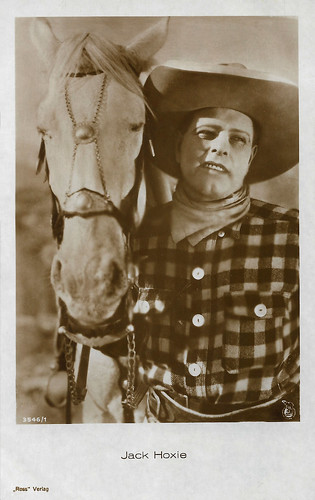
German postcard by Ross Verlag, no. 3546/1, 1928-1929. Photo: Nordisk Films.

German postcard by Ross Verlag, no. 4215/1, 1929-1930. Photo: Universal.
John Hartford 'Jack' Hoxie was born in 1885 in Kingfisher Creek in the Indian Territory (now the state of Oklahoma). Hoxie was the son of a veterinarian father, Bart 'Doc' Hoxie, and a half–Nez Perce mother (some reports list her as Cherokee), Matilda E. Hoxie (née Quick). Bart was killed in a horse accident just weeks before Jack's birth.
After his father's death, he and his mother moved to Northern Idaho where, at an early age, Jack became a working cowboy and ranch hand. Matilda married a rancher and horse trader named Calvin Scott Stone. The family then relocated to Boise, where Jack worked as a packer for a US Army fort in the area, continuing to hone his skill as a horseback rider while competing in rodeos.
In 1905, the 20-year-old Jack married Pearl Gage. The marriage lasted only a few months before the couple divorced. In 1909 he met performer Dick Stanley and joined his Wild West show. He performed as a bronc rider in the show. It was during this period that Jack met and married his second wife, Hazel Panting, who was a Western trick rider with the outfit.
According to IMDb, he had his first film role in the Western Ridin' Romance (James Young Deer, 1910) for Pathé Exchange. However, it remained for years a one-off role. Hoxie continued to tour the rodeo circuit until 1913. Then he was approached to perform in the short Western The Tragedy of Big Eagle Mine (N.N., 1913), produced by Kalem. This time his acting was the start of a continuous, highly prolific career. Now billing himself as Hart Hoxie (a moniker he would use until 1919), he would continue working through the 1910s in popular Western shorts, often in small but well-received roles.
First, he did in 1913 and 1914 a series of Western shorts at Kalem's Glendale premises in California, which were often directed by J.P. McGowan. Initially, Hoxie was the star, but his female co-actor Helen Holmes gradually increased her prominence. In 1914-1915 Hoxie became a supporting actor in Holmes's serial The Hazards of Helen (J. Gunnis Davis, J.P. McGowan, Robert G. Vignola, 1914-1915). After Kalem, Hoxie worked in 1915-1916 at Bison (part of Universal) and Universal itself, returning to Kalem in 1916 for various supporting parts in the Western thriller series The Girl from Frisco (James W. Horne, 1916), starring Marin Sais. Afterwards, various Kalem films followed.
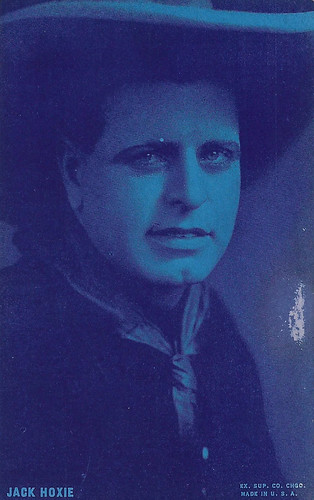
American Arcade card by Ex. Sup. Co. (Exhibition Supply Company), Chicago.

American Arcade card by Ex. Sup. Co. (Exhibition Supply Company), Chicago. Photo: Universal. Jack Hoxie in The Back Trail (George Marshall, Clifford Smith, 1924).
In 1918 Jack Hoxie had his first starring role in a feature, the Universal production The Wolf and His Mate (Edward LeSaint, 1918). Edward LeSaint also gave him first billing in Nobody's Wife. In these films, Hoxie started to use his name, Jack Hoxie, as vintage posters show (but Wikipedia and IMDb deny it). In 1919, after appearing in approximately 35 films, he was cast in the starring role in the Paul Hurst-directed Lightning Bryce serials as the main character, Sky Bryce. It was during this time that he met and married his third wife, actress and frequent co-star Marin Sais, after his divorce from Hazel Panting.
Although he rarely strayed from the Western film genre, several notable exceptions include his role as Perrone in the historical drama The Dumb Girl of Portici (1916), starring Anna Pavlova; a role in the epic drama film Joan the Woman (Cecil B. DeMille, 1916), starring Geraldine Farrar, and his role as Sandusky in the drama Nan of Music Mountain (1917), starring Wallace Reid and Ann Little.
Through the early 1920s, Hoxie became an extremely popular Western star and worked for such film companies as Ben Wilson Productions (distributed by Arrow Film) and Sunset Pictures. In 1923 Universal Pictures head Carl Laemmle put Hoxie under contract and soon his career was on par with that of other Western stars of the era: Art Acord, Harry Carey, and Hoot Gibson.
Hoxie appeared in such high-profile films as Where Is This West? (1923) with newcomer Mary Philbin and Universal's promotional film Hello, 'Frisco (1924), alongside such popular actors of the era as Jackie Coogan, Norman Kerry, Barbara La Marr, Antonio Moreno, Anna Q. Nilsson, Bebe Daniels, and Rin Tin Tin. The film was designed to showcase Universal's roster of its most popular actors.
Hoxie, often atop his horses Fender and Dynamite, would star alongside such actresses as Marceline Day, Alice Day, Helen Holmes, Louise Lovely, Lottie Pickford, and Fay Wray in Westerns throughout the silent era. Also, during this period, Jack's younger half-brother Al Stone began to appear with him in films. Al would eventually become a successful actor in the Western genre after changing his name to Al Hoxie and appearing in a series of films by actor/director J.P. McGowan.
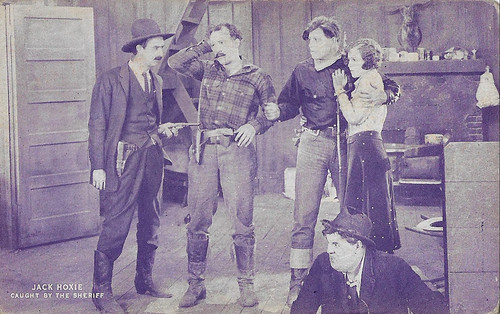
American Arcade card by Ex. Sup. Co. (Exhibition Supply Company), Chicago. Caption: Caught by the Sheriff.
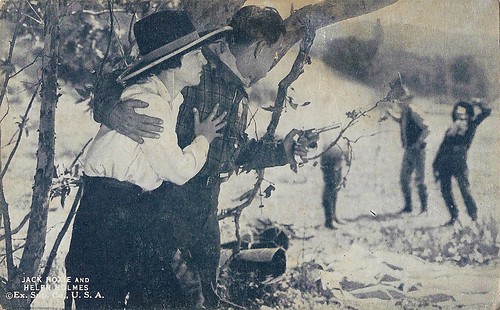
American Arcade card by Ex. Sup. Co. (Exhibition Supply Company), Chicago. Jack Hoxie and Helen Holmes in Highwayman (1926).
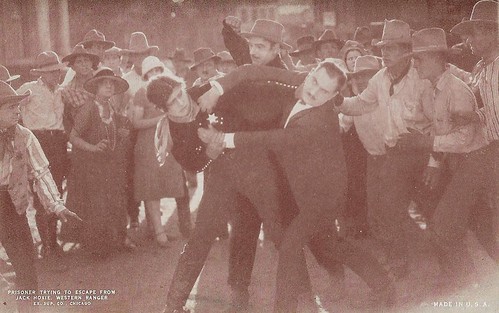
American Arcade card by Ex. Sup. Co. (Exhibition Supply Company), Chicago. Caption: Prisoner Trying to Escape from Jack Hoxie, Western Ranger.
In 1926 Carl Laemmle and Universal chose Jack Hoxie to star as Buffalo Bill Cody in Metropolitan Pictures' The Last Frontier, co-starring William Boyd. The film would prove enormously successful.
In 1927, however, Hoxie became dissatisfied with his contract at Universal and refused to renegotiate for another stint at the studio. He would continue throughout the late 1920s making films with lower-rank film studios. He made his last silent film, Forbidden Trail, in 1929 before pursuing further work in circuit rodeos, carnivals, and the Miller Brothers 101 Ranch Wild West Show.
During the 1930s Hoxie made a brief comeback in films after signing a contract with low-budget studio Majestic Pictures. The films, however, did little to revive his acting career and he once again hit the rodeo circuit. His last film appearance would be in Trouble Busters (Lewis D. Collins, 1933) with Lane Chandler, who had appeared alongside Hoxie in several earlier films.
Hoxie eventually divorced and married his fourth wife, Dixie Starr. The couple briefly operated the Broken Arrow Ranch, a dude ranch in Hereford, Arizona. After a fire consumed the ranch, Hoxie returned to Wild West shows, often billed as the "Famous Western Screen Star". Hoxie performed throughout the 1940s and well into the 1950s before finally making his last public appearance as a performer in 1959 for the Bill Tatum Circus.
Hoxie divorced Starr and married his fifth wife, Bonnie Avis Showalter, and the couple retired to a small ranch in Arkansas, then later moved to his mother Matilda's old homestead in Oklahoma. In his later years, Jack Hoxie developed leukemia, and he died in 1965, in Elkhart, Kansas, at the age of 80. He was interred at the Willowbar Cemetery in Keyes, Oklahoma with the epitaph "A Star in Life - A Star in Heaven".

German postcard by Ross Verlag, no. 4833/1, 1929-1930. Photo: DPG.

French postcard by A.N. (A. Noyer), no. 240. Photo: Universal Film.
Sources: Wikipedia, and IMDb.
This post was last updated on 25 October 2024.

German postcard by Ross Verlag, no. 3546/1, 1928-1929. Photo: Nordisk Films.

German postcard by Ross Verlag, no. 4215/1, 1929-1930. Photo: Universal.
Touring the rodeo circuit
John Hartford 'Jack' Hoxie was born in 1885 in Kingfisher Creek in the Indian Territory (now the state of Oklahoma). Hoxie was the son of a veterinarian father, Bart 'Doc' Hoxie, and a half–Nez Perce mother (some reports list her as Cherokee), Matilda E. Hoxie (née Quick). Bart was killed in a horse accident just weeks before Jack's birth.
After his father's death, he and his mother moved to Northern Idaho where, at an early age, Jack became a working cowboy and ranch hand. Matilda married a rancher and horse trader named Calvin Scott Stone. The family then relocated to Boise, where Jack worked as a packer for a US Army fort in the area, continuing to hone his skill as a horseback rider while competing in rodeos.
In 1905, the 20-year-old Jack married Pearl Gage. The marriage lasted only a few months before the couple divorced. In 1909 he met performer Dick Stanley and joined his Wild West show. He performed as a bronc rider in the show. It was during this period that Jack met and married his second wife, Hazel Panting, who was a Western trick rider with the outfit.
According to IMDb, he had his first film role in the Western Ridin' Romance (James Young Deer, 1910) for Pathé Exchange. However, it remained for years a one-off role. Hoxie continued to tour the rodeo circuit until 1913. Then he was approached to perform in the short Western The Tragedy of Big Eagle Mine (N.N., 1913), produced by Kalem. This time his acting was the start of a continuous, highly prolific career. Now billing himself as Hart Hoxie (a moniker he would use until 1919), he would continue working through the 1910s in popular Western shorts, often in small but well-received roles.
First, he did in 1913 and 1914 a series of Western shorts at Kalem's Glendale premises in California, which were often directed by J.P. McGowan. Initially, Hoxie was the star, but his female co-actor Helen Holmes gradually increased her prominence. In 1914-1915 Hoxie became a supporting actor in Holmes's serial The Hazards of Helen (J. Gunnis Davis, J.P. McGowan, Robert G. Vignola, 1914-1915). After Kalem, Hoxie worked in 1915-1916 at Bison (part of Universal) and Universal itself, returning to Kalem in 1916 for various supporting parts in the Western thriller series The Girl from Frisco (James W. Horne, 1916), starring Marin Sais. Afterwards, various Kalem films followed.

American Arcade card by Ex. Sup. Co. (Exhibition Supply Company), Chicago.

American Arcade card by Ex. Sup. Co. (Exhibition Supply Company), Chicago. Photo: Universal. Jack Hoxie in The Back Trail (George Marshall, Clifford Smith, 1924).
An extremely popular Western star
In 1918 Jack Hoxie had his first starring role in a feature, the Universal production The Wolf and His Mate (Edward LeSaint, 1918). Edward LeSaint also gave him first billing in Nobody's Wife. In these films, Hoxie started to use his name, Jack Hoxie, as vintage posters show (but Wikipedia and IMDb deny it). In 1919, after appearing in approximately 35 films, he was cast in the starring role in the Paul Hurst-directed Lightning Bryce serials as the main character, Sky Bryce. It was during this time that he met and married his third wife, actress and frequent co-star Marin Sais, after his divorce from Hazel Panting.
Although he rarely strayed from the Western film genre, several notable exceptions include his role as Perrone in the historical drama The Dumb Girl of Portici (1916), starring Anna Pavlova; a role in the epic drama film Joan the Woman (Cecil B. DeMille, 1916), starring Geraldine Farrar, and his role as Sandusky in the drama Nan of Music Mountain (1917), starring Wallace Reid and Ann Little.
Through the early 1920s, Hoxie became an extremely popular Western star and worked for such film companies as Ben Wilson Productions (distributed by Arrow Film) and Sunset Pictures. In 1923 Universal Pictures head Carl Laemmle put Hoxie under contract and soon his career was on par with that of other Western stars of the era: Art Acord, Harry Carey, and Hoot Gibson.
Hoxie appeared in such high-profile films as Where Is This West? (1923) with newcomer Mary Philbin and Universal's promotional film Hello, 'Frisco (1924), alongside such popular actors of the era as Jackie Coogan, Norman Kerry, Barbara La Marr, Antonio Moreno, Anna Q. Nilsson, Bebe Daniels, and Rin Tin Tin. The film was designed to showcase Universal's roster of its most popular actors.
Hoxie, often atop his horses Fender and Dynamite, would star alongside such actresses as Marceline Day, Alice Day, Helen Holmes, Louise Lovely, Lottie Pickford, and Fay Wray in Westerns throughout the silent era. Also, during this period, Jack's younger half-brother Al Stone began to appear with him in films. Al would eventually become a successful actor in the Western genre after changing his name to Al Hoxie and appearing in a series of films by actor/director J.P. McGowan.

American Arcade card by Ex. Sup. Co. (Exhibition Supply Company), Chicago. Caption: Caught by the Sheriff.

American Arcade card by Ex. Sup. Co. (Exhibition Supply Company), Chicago. Jack Hoxie and Helen Holmes in Highwayman (1926).

American Arcade card by Ex. Sup. Co. (Exhibition Supply Company), Chicago. Caption: Prisoner Trying to Escape from Jack Hoxie, Western Ranger.
A Star in Life - A Star in Heaven
In 1926 Carl Laemmle and Universal chose Jack Hoxie to star as Buffalo Bill Cody in Metropolitan Pictures' The Last Frontier, co-starring William Boyd. The film would prove enormously successful.
In 1927, however, Hoxie became dissatisfied with his contract at Universal and refused to renegotiate for another stint at the studio. He would continue throughout the late 1920s making films with lower-rank film studios. He made his last silent film, Forbidden Trail, in 1929 before pursuing further work in circuit rodeos, carnivals, and the Miller Brothers 101 Ranch Wild West Show.
During the 1930s Hoxie made a brief comeback in films after signing a contract with low-budget studio Majestic Pictures. The films, however, did little to revive his acting career and he once again hit the rodeo circuit. His last film appearance would be in Trouble Busters (Lewis D. Collins, 1933) with Lane Chandler, who had appeared alongside Hoxie in several earlier films.
Hoxie eventually divorced and married his fourth wife, Dixie Starr. The couple briefly operated the Broken Arrow Ranch, a dude ranch in Hereford, Arizona. After a fire consumed the ranch, Hoxie returned to Wild West shows, often billed as the "Famous Western Screen Star". Hoxie performed throughout the 1940s and well into the 1950s before finally making his last public appearance as a performer in 1959 for the Bill Tatum Circus.
Hoxie divorced Starr and married his fifth wife, Bonnie Avis Showalter, and the couple retired to a small ranch in Arkansas, then later moved to his mother Matilda's old homestead in Oklahoma. In his later years, Jack Hoxie developed leukemia, and he died in 1965, in Elkhart, Kansas, at the age of 80. He was interred at the Willowbar Cemetery in Keyes, Oklahoma with the epitaph "A Star in Life - A Star in Heaven".

German postcard by Ross Verlag, no. 4833/1, 1929-1930. Photo: DPG.

French postcard by A.N. (A. Noyer), no. 240. Photo: Universal Film.
Sources: Wikipedia, and IMDb.
This post was last updated on 25 October 2024.
No comments:
Post a Comment